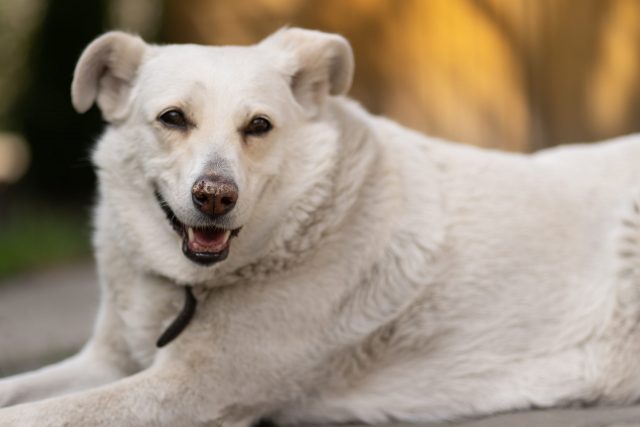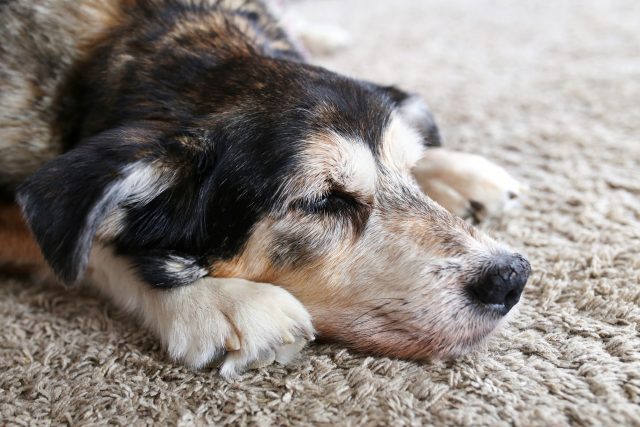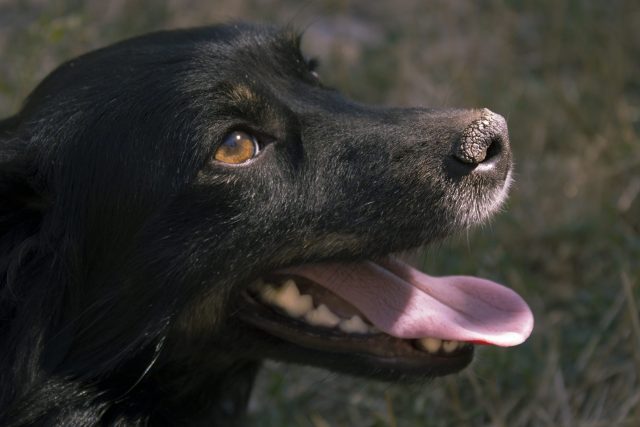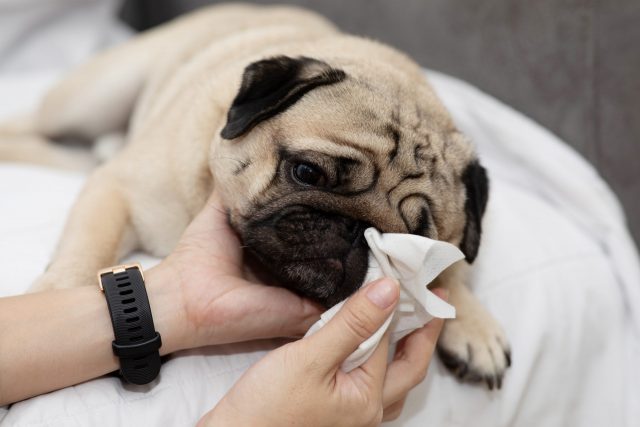iHeartDogs is reader-supported. When you buy via links on our site, we may earn an affiliate commission at no extra cost to you.
Dogs are known for having wet noses, so a dog dry nose may worry some pet parents. Sometimes, a dry nose is normal, but other times, it could be a sign of a medical concern. Paying close attention to your dog’s symptoms and their surroundings can help you understand the severity of your dog’s nose condition.
To help you understand your dog’s nose, this article will discuss what causes a dry nose in canines and how you can help your dog’s nose stay moist, healthy, and comfortable.

Why Should a Dog’s Nose Be Wet?
A dog’s nose should be wet more often than not because your dog’s nose plays a big role in their overall health and well-being. Below are the main reasons a wet nose is beneficial.
Benefits Their Sense of Smell
A dog’s sense of smell is much better than a human’s, with some sources saying it can be up to 100,000 times better. Having a wet nose improves a dog’s sense of smell because dogs have a thin layer of mucus over their nose that enhances scents for them.
You may notice some dogs lick their noses after sniffing. That’s because licking can keep the nose damp to help them take in new smells.
Helps Them Cool Down
Dogs don’t sweat everywhere like humans do, so instead, they cool down in different ways. Their tongues, nasal passageways, and the inside layer of their lungs can help them evaporate moisture to cool them off, which is why dogs pant when they’re hot. If a dog’s nose is wet, it makes the process of cooling down more effective.
Causes of Dog Dry Nose
If your dog’s nose is crusty, it could mean a lot of things. All dog noses will be dry occasionally, but if you notice a frequent dry nose, you may want to talk to your vet about it. The following are a few common causes of a dry dog nose.

Sleep
Many dogs have a dry nose after waking up from a nap. That’s because while they’re sleeping, they won’t be licking their nose. Once your dog wakes up, their nose won’t take long to become moist again since they’ll likely drink some water and lick their nose.
Dehydration
If your dog isn’t getting enough water, their nose may dry out. This is most common after intense exercise. Whenever your dog is exercising, always have water available, especially if their nose seems dry. If your dog is exhausted or sore after every time they’re active, you may want to shorten their exercise sessions.
A dry nose alone doesn’t signify that your dog is dehydrated. The best way to confirm is to look at your dog’s gums. If their gums are moist, that’s a sign that they’re hydrated. However, if the gums are dry or discolored, your dog is likely dehydrated and should visit the vet just to be safe.
In some cases, dehydration could be a sign that there’s an underlying medical concern. Diarrhea, fever, heatstroke, and vomiting could all lead to a dehydrated dog and a dry nose. If you notice unusual symptoms along with a dry nose, talk to your vet immediately.
Blocked Tear Ducts
A dog’s tear ducts can help lubricate the nose, so if they’re blocked, your dog’s nose may dry out easier. Dogs with blocked tear ducts may have red eyes and thick eye discharge. If your dog’s tear ducts are blocked frequently, you may need to talk to a vet to fix it and save your dog from the discomfort.
Exposure to Certain Elements
Some outdoor elements, such as sunlight, frigid temperatures, or allergens, could cause a dog’s nose to dry out. Whenever they’re in an environment with low humidity, there’s a risk of their nose being affected. Dogs can even get sunburned on their noses if they spend too much time outside without protection. Breeds with pink noses are the most likely to get sunburned.
If your dog’s dry nose is the result of an allergy, you’ll likely notice other allergic reactions, such as coughing, wheezing, itching, sneezing, and watery eyes.

Age or Breed
Older dogs are more likely to have dry noses, so they may need your help to keep their nose moist. If a dog struggles to reach their nose with their tongue, it can also be harder for them to keep it damp.
Some breeds, such as brachycephalic (flat-faced) breeds like Pugs and Bulldogs, are more likely to have dry noses. Breeds that are prone to having blocked tear ducts, such as Lhasa Apsos, are also prone to dried-out snouts.
Medical Concerns
If your dog’s nose is frequently dry without improving on its own, they may be experiencing a medical issue. Nasal hyperkeratosis is a condition that causes your dog’s nose to become so dry that it cracks or appears crusty. This condition can also occur on your dog’s paw pads.
In rare cases, an autoimmune disease could cause a crusty nose. Some examples include discoid lupus and pemphigus. If you suspect that the cause is something medical-related, it’s best to talk to your vet before taking action.
When is Dog Dry Nose a Concern?
Just because your dog’s nose is dry doesn’t mean there’s an immediate cause for concern. If you can, try to determine the cause of your dog’s dry nose. Short-term causes, such as waking up from a nap or exposure to an environmental factor likely aren’t an issue. But if their nose is consistently dry or paired with other symptoms, you may want to visit a vet.
Also, there’s a difference between a slightly dry nose and a nose that’s so dry it’s causing your dog discomfort. If your dog’s nose is cracking, becoming crusty, or changing color, there’s likely an underlying condition to blame. In many cases, it’s easy to treat, but a vet’s advice is essential to making sure you take the right steps.

Treatments for Dry Nose in Dogs
The treatment for your dog’s dry nose depends on the cause and severity, but here are a few cures to consider.
Providing More Water
Ensuring your dog stays hydrated is the best way to help a dog’s nose become wet again. Make sure their water bowl is always full and add more water bowls in your home if needed. If you live in an area that’s typically dry, adding a humidifier can help keep their nose moist. Dabbing a damp towel on your dog’s nose now and then may also help hydrate it.
Nose Balm
Nose balm is the most common treatment for a dry dog nose, even if your dog has nasal hyperkeratosis. These natural products can be applied to your dog’s nose daily to keep it hydrated and reduce the risk of cracking. They’re great options for senior dogs and breeds prone to dry noses. One of the best dog nose balm products is Natural Dog Company’s Snout Soother.
Anti-Allergy Medications
In some cases, a dry nose could be a sign of allergies in dogs. If you suspect your dog is reacting to an allergen, talk to your vet about an anti-allergy medication to help them. Even with a special medication, you’ll still want to keep your dog hydrated at all times.
Prescribed Antibiotics or Ointments
If natural solutions like offering more water, using a humidifier, or applying nose balm don’t work, you may need to get a prescription from your vet. Talk to your vet about your furry friend’s dry nose so they can decide if your dog needs special medication.

Can You Prevent Dry Nose in Dogs?
Even if your dog doesn’t have a dry nose, you can take precautions to prevent it from happening in the future. Prevention is especially important if you have a senior dog or brachycephalic breed. It can also be helpful if you know it’ll be drier than usual outside.
The easiest and best way to prevent dry noses is to keep your dog hydrated. As mentioned in the treatment section, you should always have water bowls accessible to your dog, especially in the rooms they spend the most time in. Plus, a humidifier can add to your dog’s hydration. Serving your dog a diet with fish oil and other hydrating ingredients can also help keep your dog’s nose healthy.
If your dog spends a lot of time outside, you might want to consider investing in dog sunscreen to put on their nose. After they’re done playing outdoors, wipe their face with a damp cloth, especially their nose, to remove dirt and debris that could dry out the skin.
Finally, regular vet visits are a great way to prevent any health conditions. When you’re at the vet, be sure to mention if you noticed anything unusual about your dog’s nose. It’s best to address these issues early on before they worsen.
A Healthy Nose Equals a Happy Dog!
Overall, a dry nose can be normal at times, but if your dog is experiencing it often or dealing with uncomfortable nose crusting or cracking, that’s when it’s time to take action. An easy, convenient way to tackle a dry dog nose is to use nose balm, which can even help with crusty, damaged noses.
We recommend Natural Dog Company’s Snout Soother because it can tackle all types of nose issues, including broken skin, skin overgrowth, and nasal hyperkeratosis. Plus, it’s made of 100% organic, plant-based ingredients that are safe for dogs to lick. You can also get 15% off your order with the code HOMELIFE15!
So, whether you’re preventing or treating a dry nose, consider a natural nose balm to keep your pup more comfortable.
 Toledo, United States.
Toledo, United States.